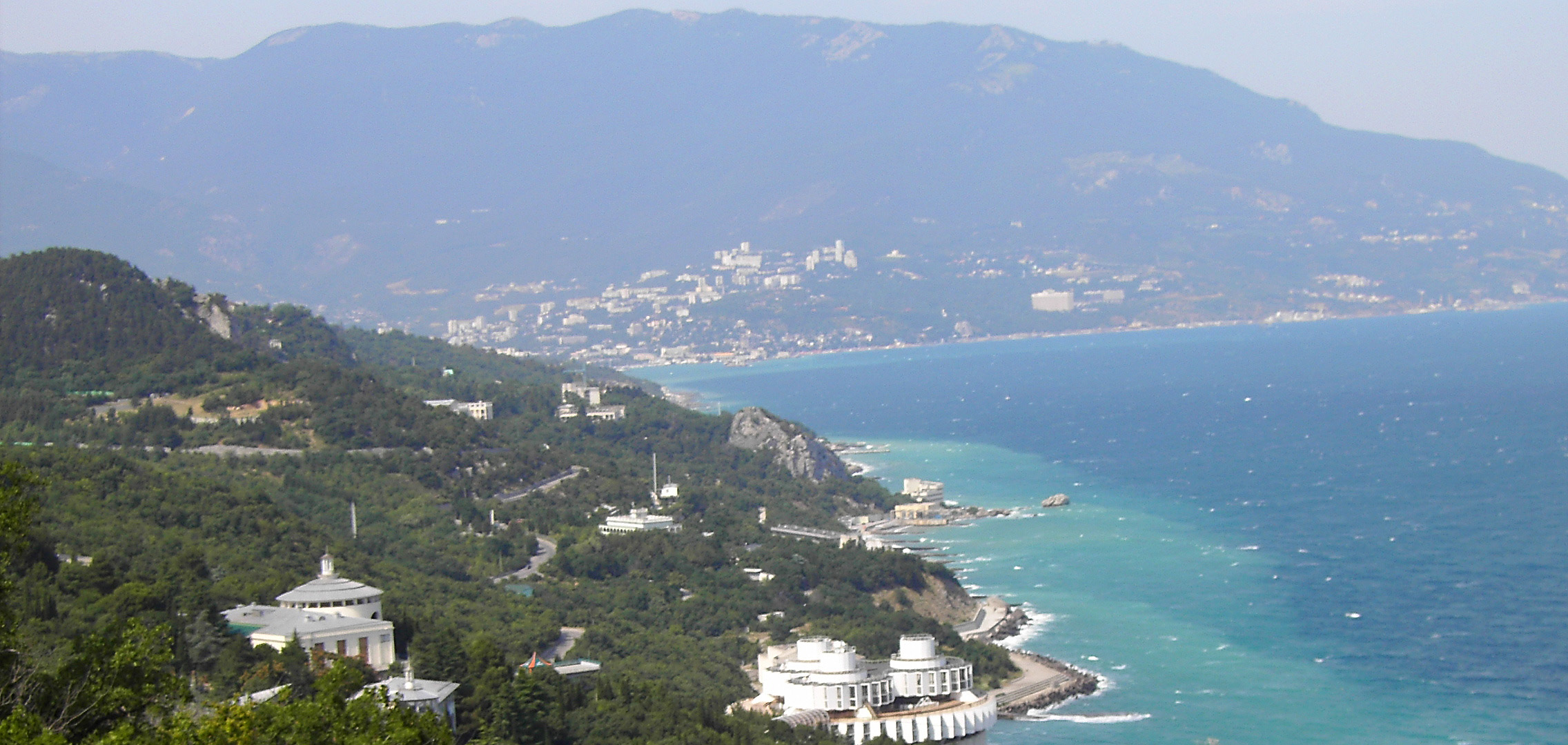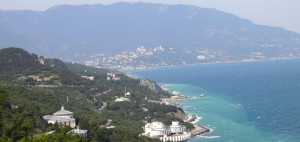
The Crimean peninsula the Jewel from the Black Sea
The Crimean peninsula the Jewel from the Black Sea
 Crimea is the name of the diamond-shaped peninsula that shines in the Black Sea. Crimea is the most fascinating corner of Ukraine. Crimea hides both, unthinkable stories and mysteries.
Crimea is the name of the diamond-shaped peninsula that shines in the Black Sea. Crimea is the most fascinating corner of Ukraine. Crimea hides both, unthinkable stories and mysteries.
Crimea is alike, a homeland and a wound bleeding nostalgia into the soul of any Tatar. Crimea is a place of meditation and pilgrimage. And last but not least, Crimea hosts the seaside resort where the World’s Powers decided the fate of Romania, throwing our country into those 45 years of communism.
This is the Crimea …
Along the Russian Riviera
The beautiful peninsula served for hundreds of years as place for promenade for the Russian aristocracy, whole generations of tsars seasonally halting here, away from the harsh Russian winter for delight and recovery. Even if Stalin decided that rocky peninsula is part of the new Ukrainian Federative Soviet Republic, Crimea has not changed its cosmopolitan air ,of a true Gate of the Orient and a place where live, in relative peace and harmony, the various people who inhabit it.
Most of those who have visited it, honestly swear that is the most beautiful and overwhelming part of Ukraine.
And people do not exaggerate!
The location has the most varied terrain, some of the most breathtaking scenery and the mildest climate of the entire Ukrainian territory. The climate, almost mediterranean turned the beaches of southern Crimea into a favorite destination for summer vacations for millions of Ukrainian, Russian or CIS citizens. And the number of Westerners, growing from year to year, leadsto the thought that the peninsula will soon become one of the favorite holiday destinations in Europe.
Spas are numerous here, and the piece of land that defiantly bites off the gloomy Black Sea is famous for its mineral waters and wines harvested here every extended autumn.
Climbing enthusiasts, photographers or those who like hiking are also not forgotten as just a few kilometers from the white beaches rise the Crimean Mountains, ancient geological formations that poke the sky up to a height of 1500 meters. It does not seem very impressive, but it is worth mentioning that here is one of the most unusual and exclusive ski slopes in the world.
How to get there, by what means of transport, what do we see and where we have fun?
The main tourist season in Crimea takes place officially in July and August, when the largest influx of tourists is recorded. But that does not mean that you should not go in any other calendar period, on the contrary. Crimea shows its true splendor in the off-season, like all the beautiful places on earth.
Strictly meteorogically speaking , this region is warm from April to October . Crimean spring is an explosion of flowers and colors, the entire peninsula being home to many species of plants. The main way of accessing Crimea is the city of Simferopol, where the one and only airport is located in the small peninsula . From here, most tourists take the train or bus routes to the southern shore or the resort of Yalta, where are the most of the sandy beaches. A flight from the Zhuliany airport from Kiev to Simferopol costs between 35-60 $. On the other hand , train tickets are much cheaper the hryvnia equivalent of 20 $ ,first class , 10 $ second , and 7 $ ” Ukrainian slow train”. All trains from Kiev via Crimea travel by night and make about 14-16 hours . The trains have stops in the major Crimean cities, Simferopol , Kerch , Sevastopol and Feodosiya. If you’re feeling adventurous on your own, you can try private minibuses (so-called marshrutka ) . They are very cheap and the driver leaves you wherever you need.
The most famous resort is by far, Yalta that became a favorite holiday destination of Russian tsars since the 19th century, after the first road was built that connects it to Simferopol.
Sevastopol, Alushta, Sudak, Feodosia, Yevpatoriya, Saki and Koktebel are other resorts that probably will not ring the bell, but worth seing them once in your life.
Sevastopol, located in the west of the peninsula, has a rich military history and tradition, being a port city more than amusement resort. But do not despair, the city has its unique charm. Here is the headquarters of the Russian Black Sea Fleet held by Russia. Sudak is famous for its scenic atmosphere and its beach tha is surprisingly well planned.
Yevpatoriya and Saki, on the west coast are famous for their large soft sand beaches. Crimean resorts are famous for their typical aspect: each benefit from an original set of historical buildings and monuments, and near the cliffs and beaches are clusters of restaurants, discos, points that serve ast food Ukrainyan style and the atmosphere is everywhere maintained by street musicians, jugglers and cartoonists. We are in Ukraine, so nightlife is at home!
Be careful though with who you go out, where you keep your money, how much you spend, and especially do not let yourself charmed by the local beauties. You do it at your own risk …
If you like solitude and look for places where nature and history are at home , or simply l for quiet and scenic” family”locations, all these, Crimea has the possibility to offer.
You can choose from hundreds of miles of deserted beaches , untouched . Wandering the sea coasts , you may come across groups of hippies , yogis and other local ” naturists ” withdrawing from civilization and live on throughout the summer in the caves near the beaches. They are generally quiet people who mind their own business and do not bother tourists . Here is the unofficial capital of nudists in Ukraine , Crimea is the meeting place for nudists even since the Soviet era.
The varied and beautiful natural landscape of Crimea offers endless opportunities for extreme sports lovers. From hiking to mountain biking, horseback riding, climbing , scuba diving , surfing, wind surfing and ending with downhill skiing , you can enjoy any way you want.
Local travel agencies deal with the organization of all events related to extreme sports and relaxation in nature. Crimean Mountains hide spectacular caves, forests of beeches, oaks, junipers, plus a long list of endemic plant species. Mountains are all accessible from the city of Simferopol and as well as from the ancient Tatar city, Bakhcisaray. The Ay-Petri mountains between Alupka and Yalta, at an altitude of 1200 meters, are excellent for skiing every winter.
Home of Tatars
You can not make a conclusive Crimean journey without reminding the turbulent ancient history of the place. Its history is ancient and complex, dating from the early Quaternary. Herson’s settlements areas (Chersoneus in ancient Greek) and Sevastopol were true outposts of ancient Greek and Hellenistic culture for two millennia …
Bahcisaray was the cramleni khans residence for hundreds of years and Kerch city has a history of about 2600 years, founded just a year after Rome.
Crimea was a wandering and settling place for dozens of peoples and tribes. Thus the ones wandering through its territory and the dust of history were the Scythians, Sarmatians, Greeks, Genoese, Venetians, Armenians, Jews, Turks, Tatars, Russians and Cossacks. Across the Crimea, Christianity, Judaism and Islam have left distinct traces and as well as in people and places. With some notable exeptions, believers of these different religions have coexisted relatively peacefully.
No other ethnic group has left its mark on the Crimean peninsula as theTatars ,and to them Crimea remained ” The Forbidden Land” but always desired and remembered in the nostalgic and unspoken dreams of every Tatar. Seen as the true “Jerusalem of the Steppes” Crimea subjugates even today the majestic and savage Tartar soul!
The original Tatars were descendants of the famous Mongol Golden Horde, displaced in this corner of the world by Batu Khan’s military expedition, none other than the grandson of the great Genghis Khan directly.
In time, the ethnic Tatars diluted, they mixing with the genetic representatives of European nations, taken as slaves and maids to Kram, as it is named in the Crimean dialect,Nogai. Remaining the masters of these places, Tatars defined themselves as a nation, have adopted Islam as the official religion in the 13th century, and built one of the most powerful states in Eastern Europe until the early 18th century, when Crimea was conquered and included in Russian tsarate.
Even though, Crimean Tatars were feared for their devastating raids undertaken in the Romanian principalities , particularly Moldavia, the Kingdom of Poland , the Lithuanian, Russian and Belarusian principalities , their strength decreases with the increasing influence in the area of the Cossacks, their traditional enemies . After the annexation of Crimea, act committed by the ambitious Empress Catherine II of Russia , Tatars are forced to emigrate in large numbers in the Ottoman Empire , some settling in Dobrogea, where you can still meet them today.
The nightmares of the Tatars became stronger under the blows of history combined with the beginnings of communism and Stalin’s regime . Strong characters, proud and faithful to ancestral traditions and family values , Tatars opposed atheism and communist notions about life and the world, sent via Moscow. During the Second World War they saw the emergence of Germans as a providential act and hoped thus allying with the Third Reich will escape communist oppression .
The choice has not been forgiven by Stalin. Although a large percentage of Tatars fought in the Red Army against the Germans, ‘ the daddy of all Nations “did not forget the cooperation between religious and political Tatar leaders with Hitler, nor the existence of so-called” Die Wolga-Tatarische Legion “or the TatarLegion, as a unit consisting of volunteer Tatars who fought (Unbeliavable!) among the feared SS brigades. Not Aryans at all their kind, but having blood ancestors valor, the warriors from the Tatar Legion impressed German commanders with their bravery.
Stalin’s answer took shape in the form of horrible mass deportations that were subjected all the Tatars on the peninsula.
This phenomenon was called Surgun in the Tatar language, and has for the descendants of the Golden Horde the same sinister resonance which has the Hebrew Holocaust. On May 18, 1944, all ethnic Tatars were forcibly loaded on trains and deported thousands of miles away in the steppes of Uzbekistan. A percentage of 47% of the population died of starvation, disease and exhaustion in the process of punishment and alienation of a nation that had stoutly opposed the Red Devil. Survivors Tatars have not returned to Crimea until the early 1980s, with the Perestroika movement.
Today, about 250,000 Tatars live in Crimea, struggling to keep their traditions, history and culture in a hectic world, which is in the process of annihilation under the roller level of globalization and consumerism.
They can be found everywhere in the peninsula. They have distinct physiognomy than that of the ukranians and speak their mother tongue proudly. They are men of honor, very respectful and hospitable, even shy.
After the fall of communism they resumed ties with the brethren in Romania, with a real nostalgic travel between Dobrogea and the Crimea. They are very glad meeting the few Romanian tourists that they meet, as they value the refuge and protection they en their brethren in Romania enjoyed the last decades. Their cuisine is delicious, original and the abundant culinary products give the true flavor of a trip to the Crimea.

Leave a Comment